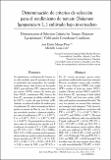| dc.creator | Monge Pérez, José Eladio | |
| dc.creator | Loría Coto, Michelle | |
| dc.date.accessioned | 2021-03-01T16:27:03Z | |
| dc.date.available | 2021-03-01T16:27:03Z | |
| dc.date.issued | 2021-02-26 | |
| dc.identifier.citation | http://ww.ucol.mx/revaia/portal/pdf/2021/enero/1.pdf | |
| dc.identifier.issn | 0188-7890 | |
| dc.identifier.uri | https://hdl.handle.net/10669/82930 | |
| dc.description.abstract | Se establecieron correlaciones de Pearson entre ocho variables, para 63 genotipos de tomate producidos bajo invernadero. Las variables evaluadas fueron: edad al inicio de la cosecha (EIC), peso del fruto (PF), número de frutos por racimo (NFR), número de lóculos por fruto (NLF), rendimiento (R), firmeza del fruto (F), porcentaje de sólidos solubles totales (SST), y acidez del jugo del fruto (pH). Además, se realizó el análisis de sendero para el rendimiento. El cultivo se manejó con fertirrigación, en sustrato de fibra de coco. Se obtuvo una correlación positiva y altamente significativa entre el rendimiento y: PF (r = 0.59**), F (r = 0.54**), NLF (r = 0.45**), y EIC (r = 0.40**). El principal efecto directo positivo sobre el rendimiento fue ejercido por F (coeficiente de sendero-CS = 0.33), seguido por PF (CS = 0.21), NFR (CS = 0.08) y NLF (CS = 0.06), mientras que los máximos efectos indirectos positivos sobre el rendimiento fueron ejercidos por PF (CS = 0.31), EIC (CS = 0.30), F (CS = 0.22), y NLF (CS = 0.22), a través de SST, y por PF (CS = 0.22) y EIC (CS = 0.20), a través de F. Por otra parte, las siguientes variables ejercieron un efecto directo negativo sobre el rendimiento: SST (CS = -0.43) y EIC (CS = -0.22). Se concluye que F y PF fueron las variables principales que contribuyeron con el rendimiento en este ensayo, y que son criterios de selección importantes en fitomejoramiento de tomate cultivado bajo invernadero. | es_ES |
| dc.description.abstract | For 63 tomato genotypes grown under greenhouse conditions the researchers estimated Pearson correlations among eight variables: days to start of harvest (DSH), fruit weight (FW), number of fruits per cluster (NFC), number of locules per fruit (NLF), yield (Y), fruit firmness (F), percentage of total soluble solids (TSS), and fruit juice acidity (pH). Also, path analysis was estimated for yield. The crop was planted on coconut fiber substrate, and managed with fertigation. Yield showed a positive and highly significant correlation with FW (r = 0.59**), F (r = 0.54**), NLF (r = 0.45**) and DSH (r = 0.40**). The main positive direct effects on yield were exhibited by F (path coefficient-PC = 0.33), FW (PC = 0.21), NFC (PC = 0.08) and NLF (PC = 0.06), while maximum positive indirect effects on yield were exhibited by FW (PC = 0.31), DSH (PC = 0.30), F (PC = 0.22) and NLF (PC = 0.22) through TSS; and FW (PC = 0.22) and DSH (PC = 0.20) through F. On the other hand, the main negative direct effects on yield were exhibited by TSS (PC = -0.43) and DSH (PC = -0.22). It is concluded that F and FW were the main yield- contributing variables in these trials, and thus represent important selection criteria for greenhouse tomato breeding. | es_ES |
| dc.language.iso | spa | es_ES |
| dc.source | Avances en Investigación Agropecuaria 25(1): 7-19. 2021 | es_ES |
| dc.subject | calidad | es_ES |
| dc.subject | rendimiento | es_ES |
| dc.subject | firmeza | es_ES |
| dc.subject | peso | es_ES |
| dc.subject | fitomejoramiento | es_ES |
| dc.title | Determinación de criterios de selección para el rendimiento de tomate (Solanum lycopersicum L.) cultivado bajo invernadero | es_ES |
| dc.title.alternative | Determination of selection criteria for tomato (Solanum lycopersicum) yield under greenhouse conditions | es_ES |
| dc.type | artículo original | |
| dc.description.procedence | UCR::Vicerrectoría de Investigación::Unidades de Investigación::Ciencias Agroalimentarias::Estación Experimental Agrícola Fabio Baudrit Moreno (EEAFBM) | es_ES |


